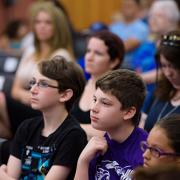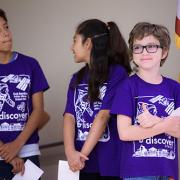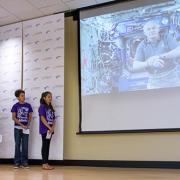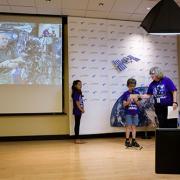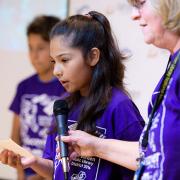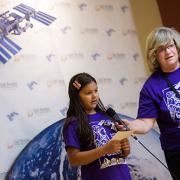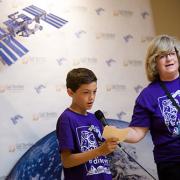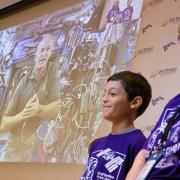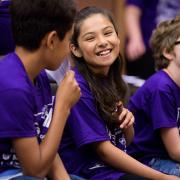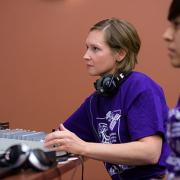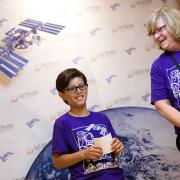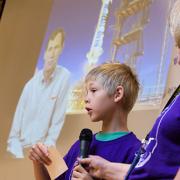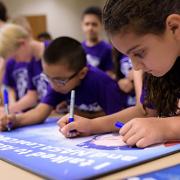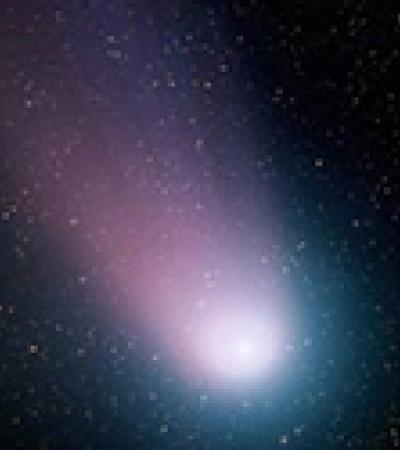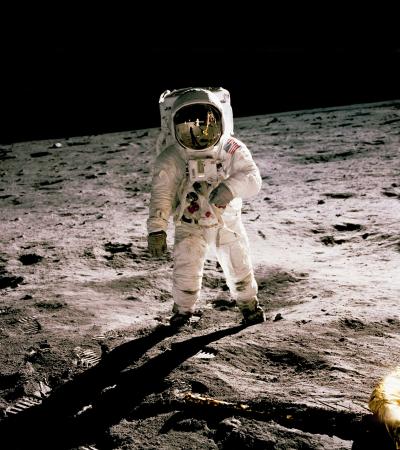Children
Tweens (10-12)
Young Adult
Adults
Intergenerational
Live Video Chat with NASA Astronaut Aboard the International Space Station
Free
Through a competitive application process hosted by NASA, Gail Borden Public Library was able to host a NASA In-flight Educational Downlink. Young people from our library were able to ask questions via video conference to NASA Astronaut Jeff Williams while he was aboard the International Space Station (ISS) on June 30, 2016.
The chat was streamed live in a variety of channels: NASA TV, NASA's website, the library's YouTube Channel and the library's Facebook page using Facebook Live. In addition to NASA's channels, more than 4,000 people engaged with this event through the library's social media. Over 230 people watched the event live in our building.
This program was offered as part of Discover Space: A Cosmic Journey, a traveling exhibition offered by the American Library Association (ALA) Public Programs Office, in collaboration with the Space Science Institute’s National Center for Interactive Learning, the Lunar and Planetary Institute and the Afterschool Alliance. Gail Borden Public Library was one of eight libraries selected to host the exhibition.
Advanced Planning
When we learned that we had been selected to host the STAR_Net Discover Space exhibit in April through early July of 2016, we worked actively to enhance engagement with the exhibit and its contents. We knew what kind of impact a live ISS event could have on kids' lives due to our experiencing hosting an audio chat with NASA astronauts in 2007. This 2007 event had inspired or furthered interest in technology, and when speaking with ALA about the potential of hosting a Downlink, we wanted to emphasize how powerful libraries are with regard to STEM education.
Therefore, we applied for a Downlink seeking support letters from the local school district and Hal Getzelman, an Elgin native, who works as a NASA ISS Lead Communicator in Houston. Both wrote letters, and we also emphasized partnerships and library impact. We wrote about ALA's support, noting the huge impact this Downlink would have even in other libraries. We started the process seven months before hosting the Downlink.
There were challenges with planning, since our newsletter is sent every two months. Without finding out whether we would definitely receive the Downlink until April, we had to discuss other potential events in the newsletter and elsewhere.
Marketing
We promoted this event through all possible channels: print (press and our own print vehicles), partner marketing (schools and other), web and social media. Marketing from ALA helped this event grow to a whole other level. NASA also promoted it through their vehicles. One of the reporters covering from Medill News Services said she saw it on AP news service.
With the huge numbers of people engaged with social media streams for this event, we believe we were successful. Parents, children and community members who participated or watched were "blown away" by the experience. Our local press responded with great coverage, both before and after. The numbers and responses from other libraries and schools across the country indicated that other organizations interested in STEM education found it worthy.
This was a message received from one library: "It was a nice event to bring generations together, one generation that remembers seeing/hearing live NASA broadcasts back in the '60s and the other, a new generation! One young woman said she wants to be an astronaut and can’t wait for the next broadcast. Thank you for inviting all libraries to join in and watch your event and we wish you the best! Congrats for hosting such a great experience for libraries and children!"
Budgeting
Staff time was the biggest cost. There is the application process, and then there is the testing process. We needed to set everything up and practice, since NASA requires some testing before the main event. The actual Downlink was free of charge. NASA sent a backup phone module in case the video did not work, and we used our own cameras.
We used two different sound boards because we wanted to have a separate audio soundtrack, but we borrowed these from the city and a volunteer. You would not absolutely have to have them, as the cost of renting one might be around $300- 500 depending on where you live and the number of days you are renting. It is useful to have people with technical expertise - we were lucky we had someone on staff that was experienced with a soundboard already. Another option is using two microphones, one feeding the room PA and one feeding the laptop for the downlink. Before we decided to go with the soundboard, we actually purchased a 2 mic adaptor for a mic stand for under $20, in case we wanted to go the two-mic option.
We also purchased t-shirts for all of the participating staff members and kids at the event, at $6.00 each. For the "typical" NASA Downlink (ours involved more people), there would be approximately 14 kids and at least 5 adults, so if you wanted to print t-shirts for you participants it would run around $100.00. I recommended incurring this small cost if possible, since it made the event more special for everyone.
Day-of-event Activity
The Downlink event was at 11:30 a.m., and we had staff and volunteers arrive two hours early to make sure all the technical equipment was working. As we wanted to use the same audio feed in the room for our attendees, there were a lot of moving parts, but this level of audio wouldn’t be necessary for everyone.
We had staff in charge of seating in the room, and they also were in charge of the children who read the questions to astronaut Jeff Williams. All of the chairs were marked with the children’s names and their questions were on cards for them. We asked them to be present an hour before the event.
All people working the event had timelines and scripts, as NASA provides a script to follow. Questions had been submitted a week earlier for final NASA approval.
We had a press section reserved, but the photographers were respectful about being in places that didn't impact our cameras. We notified kids and their families that we would like some to stay around afterwards to talk to reporters, and also let children and families know that we would be taking group photos after the event.
The floor was taped so the children would know where they should stand at all times.
NASA and the library staff exchanged phone numbers so we could call each other separate from the live chat, and these numbers were used behind the scenes to touch based throughout the event. NASA also supplied an educator and a technical director for the event.
Program Execution
Thousands watched on the social media stream and the feedback was all about how extraordinary this event was (view video of the Downlink under Watch Video at right). There are also now 31 children who experienced a once-in-a-lifetime event (view photos of some of these children asking their questions under Photo Slideshow at right). Our community once again has learned how this library impacts young lives. We are so happy that other libraries watched. We do not know exactly how the lives of these 2016 kids will be impacted.
However, because we did hosted a similar event, we do have some idea. From Carol McKellar, the mother of two children from the 2007 program:
“Gail Borden Public Library has played a pivotal role in the life of [my children] Kristen and Matthew, most notably, the Space, Dare to Dream event. As they continue to pursue their interest in robotics, I remember each of their questions for astronaut Clay Anderson on the ISS Expedition 15 [during the 2007 audio event hosted by GBPLD]; Kristen asked about the computers used on the ISS and Matthew asked about a robotic aerocam that was in development at the time.
"Today as Matthew and Kristen are moving into yet another level of FIRST robotics competitions — FIRST Technical Challenge (FTC), a high school-age program — Kristen is still focused on computer programming, and Matthew is still focused on engineering. This begins their fifth year of competitive robotics and they're still going strong. We are grateful for the continuing opportunities GBPL has provided through the years.”
For program evaluation, we had a metrics document to complete for NASA which included attendance in person and online. We also included in our report to them. Here is a sample of some of the news coverage of the event:
- “Elgin-area students video chat with astronaut on space station” (Daily Herald, June 30)
- “Chit Chat: St. Charles boy gets out-of-this-world experience” (Kane County Chronicle, July 4)
- “Students will talk live with a NASA astronaut” (MSN.com, June 29)
Advice
I would definitely recommend practicing with the soundboard if you want to use one. We decided to use one because we wanted the feed that the audience was hearing to also feed our video. In addition, we were lucky to have a partner with a soundboard and the expertise.
This is an exhilarating experience for children, their families, staff and the community. It can change lives. It can bring new visibility about the importance that a library can play in science and technology education.
Supporting Materials
- Feedback (Coming Soon!)
- Programming Librarian Facebook Group

